Authentic Mexican Carnitas
This post may contain affiliate links. Please read my disclosure policy.
This authentic carnitas recipe creates incredibly flavorful, tender Mexican pork! Make this recipe for family dinners or for a party crowd.

These Mexican carnitas may take a little longer to make, but the steps are very simple. We’re talking fried pork… crispy outside, tender and flavorful inside. When shredded and stuffed inside a taco with onion, cilantro and a squeeze of lime, it’s simply THE BEST.
By combining a few traditional cooking tricks such as a flavorful bundle of seasonings, this carnitas recipe makes a meal that is sure to become a favorite. I love making a LARGE batch and serving this for family, on Cinco de Mayo and potlucks because it feeds a crowd and the sides are endless.
It’s great to have leftovers, too. My Carnitas Enchiladas are a great way to stretch this meal.
Authentic Carnitas Recipe FAQ
The Spanish word carnitas in English means “little meats”. Traditionally, an authentic carnitas recipe is made by braising or simmering pork in lard or oil until tender.
This is a dish of Mexican cuisine that originated in the state of Michoacán. Carnitas are made from pork shoulder (pork butt).
Milk is a tenderizer. Similar to using buttermilk for tender buttermilk biscuits or a fluffy pancake recipe, the milk breaks down the toughness of the pork so that it comes out juicy and flavorful.
Ingredients
- Boneless pork shoulder – also known as pork butt, cut into chunks for faster cooking
- Pork lard – this is what makes the meat crisp on the outside and tender on the inside
- Piloncillo – a raw form of pure cane sugar, also known as Mexican brown sugar
- Milk – adds extra flavor to the meat, helps break down meat proteins to get tender
- Seasoning bundle – garlic, orange, onion, bay leaves, Mexican oregano, cinnamon stick

Video: Making authentic pork carnitas
There are several different ways to make carnitas, including slow cooking or using a pressure cooker. I have those recipes already on the site here, check them out!
What makes this an authentic carnitas recipe is that the pork butt is going old school and boiling the dry rubbed pork in lard. Using this method of cooking guarantees the perfect texture – tender and juicy pieces of meat with perfectly crisp edges.
To see the process of making an authentic carnitas recipe from start to finish, watch the video located in the recipe card at the bottom of this post!

Recipe notes and tips
Here are several more important tips for making Mexican carnitas:
- Preparing the pork butt
One of the most important steps is to dry brine the meat overnight. Doing this allows the salt to penetrate deep into the meat and lock in the moisture.
Simply rub kosher salt over all of the pork pieces and refrigerate in a sealed container for at least 12 hours.
- Cooking the meat
Before you get started, remove the meat from the refrigerator and let it rest on the counter.
Bringing the meat to room temperature first helps it cook more evenly. It also keeps the meat from seizing when added to the hot lard, which would prevent it from being melt-in-your-mouth tender.
Once you have everything boiling, keep an eye on the color of the meat. You may need to lower the temperature on the stove if the meat starts to brown too quickly.
- Finishing the pork carnitas
After the initial cook is done, add the milk. It will boil initially, but don’t let it continue to boil. Doing so will cause it to sour and curdle.
Watch the temperature during the final cooking process. The meat needs to continue to simmer, but don’t let it come back to a boil.
Let the pork shoulder cool before shredding. If you shred the meat when it’s still hot, the juices will escape and you’ll be left with dry carnitas.

How to serve authentic carnitas
Because the meat is so tender and flavorful, you’ll be tempted to eat it straight off the plate!
To make a meal out of your carnitas meat, shred and serve with:
- corn or flour torillas
- refried beans
- white onions, sliced
- fresh cilantro, chopped
- limes, sliced for squeezing over everything
Add extra fresh flavor with your choice of homemade salsas and spreads:
If there are any leftovers, which is rare in my house, try using them to make a Cuban sandwich. It’s simply AMAZING!

This post, originally published on Kevin is Cooking April 20, 2020, was last updated with new content on Oct. 18, 2021.
Subscribe to my Newsletter, follow me on Facebook, Pinterest, Instagram and YouTube for all my latest recipes and videos.

Authentic Carnitas Recipe
Ingredients
Carnitas
- 6 lbs boneless pork shoulder (pork butt), cut into 3-inch chunks
- 1 tbsp salt
Seasoning Bundle
- 6 garlic cloves
- 1/2 orange
- 1/2 onion
- 3 bay leaves
- 2 tbsp Mexican oregano (See Note 1)
- 1 cinnamon stick
Frying
- 4 lbs pork lard (See Note 2)
- 2 oz Piloncillo or brown sugar (See Note 3)
- 1/3 cup milk
Serving
- flour or corn tortillas
- refried beans
- 2 white onions sliced
- 1 bunch of cilantro chopped
- 3 limes sliced
- salsa verde
- roasted tomato salsa
- guacamole
- pickled carrots
Instructions
- Rub the kosher salt over pork. Place in a sealed container and refrigerate over night.
- Remove pork from refrigerator and allow to come to room temperature.
- In a large piece of cheesecloth, wrap the garlic cloves, orange, onion, bay leaves, Mexican oregano and cinnamon stick and secure with kitchen twine.
Frying
- Melt the lard in a large, heavy stock pot over high heat. Carefully add the Seasoning Bundle, piloncillo (or brown sugar) and pork chunks.
- Bring lard to a boil over high heat (350°F), lower to medium (adjust heat to medium low if pork turns brown too quickly) and cook, stirring often, for 90 minutes. Pork will turn a golden brown. Do not exceed to 370°F which is the smoking point of lard.
- Turn heat to low and carefully add the milk. Stir and it will boil slightly for 30 seconds. Simmer for 20-30 minutes until meat is fall apart tender when gently squeezed with tongs or fork.
- Carefully transfer pork from oil using a slotted spoon or spider to a serving platter lined with paper towels. Allow meat to cool slightly and shred by hand or using forks.
- Serve with hot tortillas, refried beans, sliced onions, tomato slices, cilantro, limes and salsas of choice.
Video
Notes
- Mexican oregano is a relative of Lemon Verbena and is native to Mexico. Similar in that it’s pungent like Mediterranean oregano, Mexican oregano has notes of mild licorice and citrus. Mediterranean oregano is a member of the mint family and most often is used in Greek and Italian recipes. Mediterranean oregano is the one most found in spice racks and supermarkets.
- I buy ARMOUR Manteca/Lard in a 4 pound tub found near the butcher/meat section at my local market. Remember to boil and keep at 350°F. Do not exceed 365-370°F, which is the smoking point of lard.
- Piloncillo is cane sugar, similar in taste to molasses and can be found at most Mexican/Latin markets. It comes in a 8 ounce cone shape, wrapped in plastic. For this recipe you just need 2 ounces, I chop off a quarter chunk, or if I do not have any on hand, will substitute a 1/4 cup of brown sugar.
- **NUTRITIONAL info is for carnitas meat only. Fat and calorie counts stated here are high and do not take into account the discarded fat it is fried in.
- Slightly adapted from Gonzalo Guzman’s, Nopalito.
Nutrition
The information shown is an estimate provided by an online nutrition calculator. It should not be considered a substitute for a professional nutritionist’s advice.
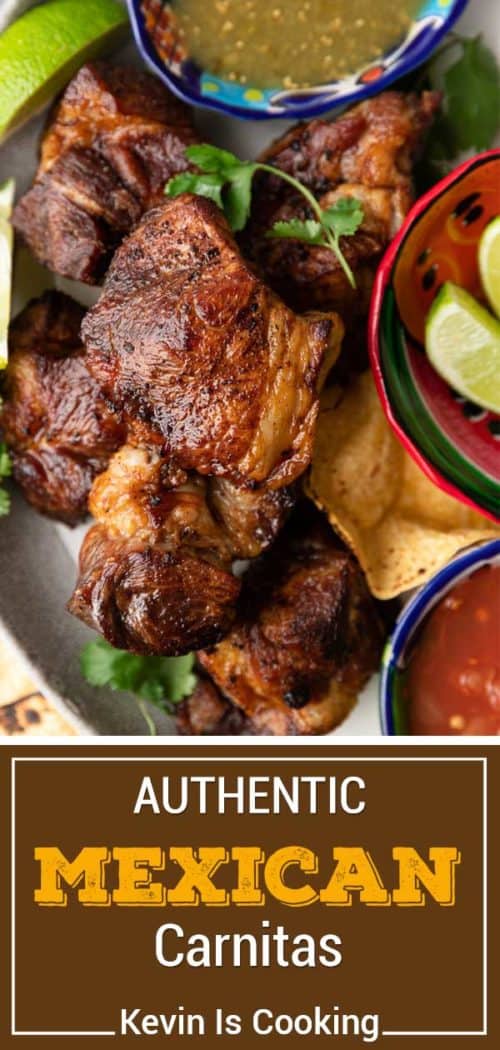

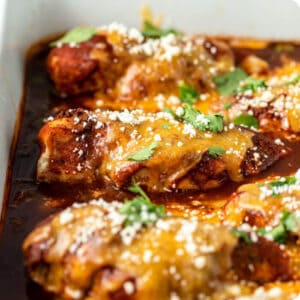
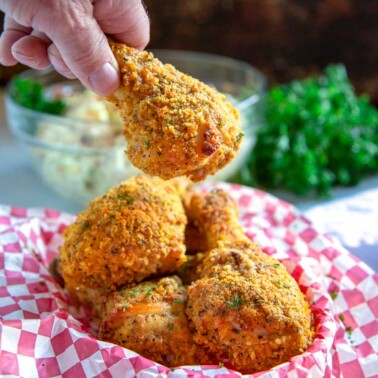
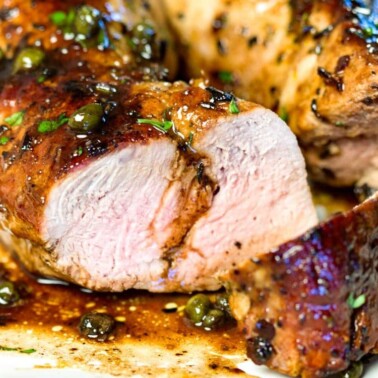
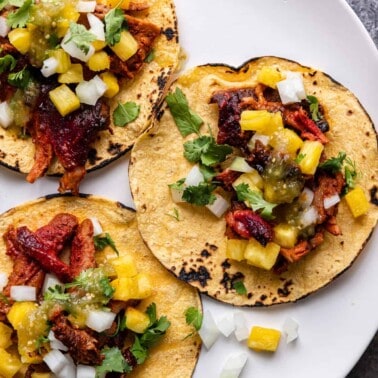
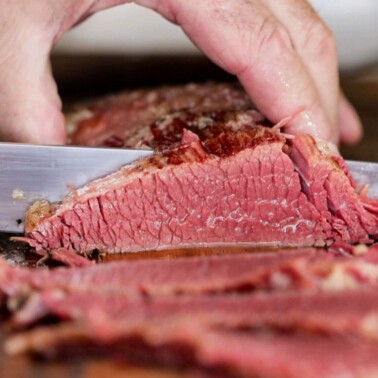












Thank you! Wonderful recipes!! God bless you!!
Thank you so much Serena!
Kevin, can I boil this in Crisco?
Yes you can Renee.
How long can I leave the salted pork in the refrigerator? I have to salt before I go to bed but then I can’t cook until after work the next day. Renee
You’ll be fine Renee. Enjoy this one!
The recipe is tasty and they are really tender and delicious. I had trouble at the browning when the water all evaporated and I was actually frying in the lard and pork fat. All the sugar and bits stuck to the bottom and burned. I think next time I’ll boil in one pot then fry in another to get that good crisp outside.
Glad you gave this one a go Ed!
Some Miss information going on here concerning boil temperature of the lard. Couple comments say to boil it at 370° but that is actually the smoke point of lard not the boil point. You will be deep frying at 370°.
Remember to boil and keep at 350°F. Do not exceed 365-370°F, which is the smoking point of lard.
Hi, I’m a little confused. I want to reuse my lard, but you say in comment below that it should not be heated over 360º, but then you say in another comment that it needs to boil at 370º. Please advise. Getting ready to make this so I need confirmation please.
Thanks for reaching out and good question Joanne. It is indeed 370°F or 185°C, fixed the typo.
Do you add the milk to the oil and finish cooking thevport in both for the last 30 minutes?
Yes, just like in the video and instructions Becky. You got this!
Hi Kevin. Loved the video! Just what I was looking for too. Question…
Is it safe to store and reuse meat lard for another time? If so are there any health tips or recommendations to keep in mind when doing so…besides letting the lard cool and straining it? How many uses could one get out of it if properly stored?
Yes, you can reuse lard after frying, but be careful. Lard shouldn’t be heated above 370°F or 185 degrees Celsius. Overheating will degrade lard and cause it to become dangerous to consume. Be careful of that and once finished, let cool, strain and store in an airtight container and refrigerate to be careful. It can be used 3-4 more times. Hope this helps and when in doubt, Google it! 🙂
I forgot to strain it last night after making this recipe. It is in the fridge, so can I re melt it and still strain it? They turned out great by the way.
I would melt it again, strain and let it cool before storing again in fridge. Thanks for trying and thanks for sharing the pics Christine! You’re making me hungry. 🙂
It says nutrition but I missed the portion size info. The calorie count is high but how much is that actually? 3 oz, 4?
NUTRITIONAL info is for carnitas meat only. Fat and calorie counts stated here are high and do not take into account the discarded fat it is fried in. I wish I could give you an exact amount, but everyone has different portion sizes.
This is a game changer. It is worth the effort- don’t skip any of the steps to save time. Thank you Kevin!
Thanks for making my day, so happy you enjoyed them Jimmy!
Do you have a recommended temp for the lard?
Nic, you’ll need to melt the lard in a large, heavy stock pot over high heat. Once the Seasoning Bundle, piloncillo (or brown sugar) and pork chunks go in you bring it to a boil (keep it at 350°F), then lower heat to medium and cook for 90 minutes. To be technical, I had to look it up: At what temperature does lard boil, 350°F, it will reach smoking point at 370°F/185°C. Hope this helps.
I didn’t purchase enough lard. Can I use vegetable oil instead of the lard?
Yes, not a problem Darlene.
What if I don’t have the spice bag, can I just add ingredients to the pot?
You could, but you could also use a tied piece of cheesecloth or maybe use a coffee filter if you have, too?